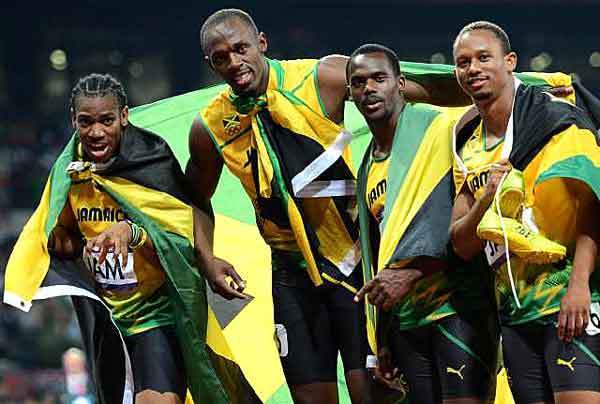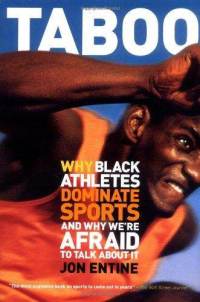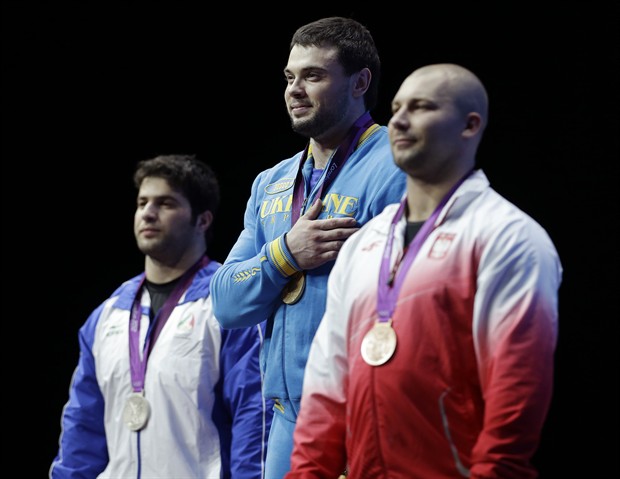Led by 100-meter world record holder Usain Bolt, Jamaican men swept the sprinting events at the London Olympics. It was a stunning feat for the small Caribbean nation. But as part of a broader trend, it’s hardly surprising. Runners of West African descent are the fastest humans on earth.
For decades, a bushel of developing countries—Jamaica, Cuba, Trinidad and Tobago, Saint Kitts, Barbados, Grenada, Netherlands Antilles and the Bahamas in the Caribbean and Nigeria, Cameroon, Ivory Coast, Senegal and Namibia in western Africa, as single countries, have each produced more elite male sprinters than all of white Europe and Asia combined. Yet West African descended runners are laggards at the longer races.
Remarkably, the story of East African runners is the mirror image of the West African success story. While terrible at the sprints, runners Kenya, Ethiopia and Somalia, along with a sprinkling of North and Southern Africans, regularly dominate endurance running.
And if you are an Asian or white runner? Forgetaboutit.
Unlike the props and costumes required for, say, fencing, or the intense coaching demanded of gymnastics, running requires only that you lace ‘em up. Ethiopia’s Abebe Bikila proved this quite memorably in the 1960 Rome Olympics, when—shoeless, coachless and inexperienced—he won the marathon.
 Running is a natural laboratory for the science of sports. It’s empirically driven. There are winners and losers. No soft-headed sociological mumbo-jumbo allowed.
Running is a natural laboratory for the science of sports. It’s empirically driven. There are winners and losers. No soft-headed sociological mumbo-jumbo allowed.
The fact is, over the past fifty years, as the barriers to competition, at least for men, have gradually eroded, and equality of opportunity has steadily spread to vast sections of once poverty-stricken Asia and Africa, one might expect that running results would have become more democratic. The medal podium should look like a rainbow of racial equality, a United Nations of sports. But just the opposite has happened.
The trends are eye opening: Athletes of African ancestry hold every major male running record, from the 100 meters to the marathon. (Although these same trends hold for female runners, the pattern is more dominant among male runners. This analysis focuses on men because the playing field for them is far more level, as social taboos remain that restrict female access to sports in many parts of the world.)
Over the last seven Olympic men’s 100-meter races, all 56 finalists have been of West African descent. Only two non-African runners, France’s Christophe Lemaire, who is white, and Australia’s Irish-aboriginal Patrick Johnson, have cracked the top 500 100-meter times. There are no elite Asian sprinters—or, intriguingly, any from East or North Africa.
Cultural myths
What’s going on here? The most frequently heard explanation is that African athletes just work harder at running. It’s one of their few outlets, the story goes, to escape the trap of limited opportunities. There’s a tradition of running that young athletes emulate; they’ve been running to school since kindergarten; they train harder for a chance at the golden ring that athletic success offers; or athletes from other parts of the world have developed a toxic inferiority complex, a fear of ‘black athletes’; blah, blah,blah.
National Public Radio recently carried just such a speculative piece on Kenya, and CNN had its own version on Jamaica. Never did the word “genetics” find its way into the story. It’s all nurture, they concluded—the long since scientifically discredited tabula rasa theory of human achievement.
No one outside of the most politically correct circles really believes that. Certainly scientists don’t. The director of the Copenhagen Muscle Research Institute, Bengt Saltin, the world’s premier expert in human performance and race, has concluded that an athlete’s “environment” accounts for no more than 20-25 percent of athletic ability. The rest comes down to the roll of the genetic dice—with each population group having distinct advantages. In other words, running success is “in the genes.”
Here are the facts. Athletic success, like success of all kind, is a bio-cultural phenomenon. Humans are not blank slates. While culture, environment, individual initiative and just plain luck might heavily influence which individuals succeed nature circumscribes the possibility of even being in the game.
Genetically linked, highly heritable characteristics such as skeletal structure, the distribution of muscle fiber types (for example, sprinters have more natural fast twitch fibers, while distance runners are naturally endowed with more of the slow twitch variety), reflex capabilities, metabolic efficiency and lung capacity are not evenly distributed among populations.
Do we yet know the specific genes that contribute to on the field success? No, but that’s not an argument against the powerful role of genetics in sports. We do not yet know all the factors that determine skin color, but we know that genetics determines it. Slowly, geneticists will link human performance, including sports skills, to our DNA and more specifically to our ancestral roots—populations.
This is uncontroversial and incontrovertible science even to anti-hereditarian ideologues. British biologist Steven Rose, one of the world’s most famous critics of biological determinism, recently wrote, “There are…probably genetic as well as environmental reasons why Ethiopians make good marathon runners whereas Nigerians on the whole do not.”
Yet the subject remains a prickly one to many journalists and the ‘liberal’ chattering classes. Michael Johnson stirred quite a controversy last month in London when the 400-meter world record holder postulated that black sprinters benefit from the outsized presence of ACTN3. The “speed gene” as it’s been dubbed, makes fast twitch muscles twitch fast. Lacking the ACTN3 protein does not seem to have any harmful health effects, but does affect running ability. Scientists conclude that it is almost impossible for someone who lacks the ACTN3 protein to become an elite sprinter. Those of African ancestry have the lowest incidence of the mutation that prevents the muscles from firing.
Is this running’s “smoking gun” gene? No. Sports ability, like IQ, is the product of many genes with environmental triggers influencing the “expression” of our base DNA. But its isolation does underscore that when it comes to performance, genes matter.
Why touch this third rail of race? After all, as UCLA’s Jared Diamond has noted, “Even today, few scientists dare to study racial origins, lest they be branded racists just for being interested in the subject.”
Athletic achievement has long been a Catch-22 for blacks in general and African Americans in particular. In the early part of the 20th century, when blacks first got a chance to compete in sports, every defeat encouraged simplistic, racist beliefs that blacks were an inferior “race,” too frail to handle extreme physical challenges and not smart enough to plan a race strategy.
Even winning didn’t shatter the stereotype; racist whites just created a new one. When Jesse Owens won four gold medals at the 1936 Berlin Olympics, shocking the Nazi hosts, a diametrically opposed but equally noxious myth became cemented: black athletes succeed because of their “natural” athleticism. As for the potential for black coaches or managers to succeed? Well...ask Al Campanis about that.
Black success in sports in every aspect of sports has shattered that stereotype. But the pendulum has swung to hard the other way, from pure determinism to pure sociological speculation. Success in sports is now primarily attributed almost solely to hard work and cultural factors. In the light of what we know about genetics, that very American, egalitarian belief meme is too glib, simplistic and maybe even dangerous.
 The hard truth is that we cannot avoid confronting the fact of our patterned human biodiversity. Over the past decade, human genome research has moved from a study of human similarities to a focus on population-based differences. Such research offers clues to solving the mystery of disease, the Holy Grail of genetics. So why do we readily accept that evolution has turned out Jews with a genetic predisposition to Tay-Sachs, Southeast Asians with a higher proclivity for beta-thalassemia and blacks who are susceptible to colorectal cancer and sickle cell disease, yet find it racist to suggest that Usain Bolt can thank his West African ancestry for the most critical part of his success—his biological possibility?
The hard truth is that we cannot avoid confronting the fact of our patterned human biodiversity. Over the past decade, human genome research has moved from a study of human similarities to a focus on population-based differences. Such research offers clues to solving the mystery of disease, the Holy Grail of genetics. So why do we readily accept that evolution has turned out Jews with a genetic predisposition to Tay-Sachs, Southeast Asians with a higher proclivity for beta-thalassemia and blacks who are susceptible to colorectal cancer and sickle cell disease, yet find it racist to suggest that Usain Bolt can thank his West African ancestry for the most critical part of his success—his biological possibility?
“Differences among athletes of elite caliber are so small,” said Robert Malina, a retired Michigan State University anthropologist and former editor of the Journal of Human Genetics, “that if you have a physique or the ability to fire muscle fibers more efficiently that might be genetically based ... it might be very, very significant. The fraction of a second is the difference between the gold medal and fourth place.”
Bio-cultural athletic hotspots
Indeed, the empirical evidence makes hash of the myth that culture is most responsible for making the athlete. Look at Kenya: with but 43 million people, this comparatively tiny country holds more than one third of top times in distance races. What explains this phenomenon? It’s in their culture, say many social scientists. Kenyans dominate distance races because they “naturally trained” as children—by running back and forth to school, for example.
“That’s just silly,” Kenyan-born Wilson Kipketer told me. Kipketer currently holds 8 of the 17 all-time fastest 800-meter times, a middle distance track event. “I lived right next door to school,” he laughed, dismissing cookie-cutter explanations. “I walked, nice and slow.” What motivated him to pursue running? Like most young Kenyans, while growing up Kipketer hoped that he migh catch the eye of a coach who combs the countryside to find the next generation of budding stars. He had dreams of being cheered as he entered the National Stadium in Nairobi.Only one problem: the national sport, the hero worship, the adoring fans, the social channeling—that all speaks to Kenya's enduring love affair with soccer, not running. But Kipketer, like most Kenyans, was not very good at soccer; Kenyans and East Africans in general tend to be short and slender with large natural lung capacity and a preponderance of slow twitch muscles. It’s a perfect biomechanical package for long distance running, but a disaster for sports that require anaerobic bursts, like sprinting or soccer. Indeed, Kenya’s fastest 100-meter time, 10.26, is a half second slower than Bolt’s world record. There are more than 5,000 times ranked higher than Kenya’s best.
Although people in every population come in all shapes and sizes, body types and physiological characteristics follow a Gaussian distribution curve as a result of evolutionary adaptations by our ancestors to extremely varied environmental challenges. Elite sports showcase these differences. Asians, on average, tend to be smaller with shorter extremities and long torsos—evolutionary adaptations to harsh climes encountered by Homo sapiens who migrated to Northeast Asia 40,000 years ago. China, for example, excels in many Olympic sports, for a variety of reasons. One of those reasons, according to geneticists, is that they are more flexible on average—a potential advantage in diving, gymnastics (hence the term “Chinese splits”) and figure skating.
Whites of Eurasian ancestry are mesomorphic: they have larger and relatively more muscular bodies with comparatively short limbs and thick torsos. No prototypical sprinter or marathoner here. These proportions are advantageous in sports in which strength rather than speed is at a premium. Predictably, Eurasians dominate weightlifting, wrestling and most field events, such as the shot put and hammer. At the London Olympics, with the exception of North Korea, the top lifters come from a band of Eurasian countries: China, Kazakhstan, Iran, Poland, Russia and the Ukraine. Despite the image of the sculpted African body, no African nation won an Olympic lifting medal.
What about West Africans and North American, Caribbean and European blacks who trace their ancestry to the Middle Passage? They generally have: bigger, more developed overall musculature;narrower hips, lighter calves; higher levels of plasma testosterone; faster patellar tendon reflex in the knee; and a higher percentage of fast-twitch muscles and more anaerobic enzymes, which can translate into more explosive energy. Blacks in general have heavier skeletons and less body fat—key genetic hindrances when it comes to such sports as competitive swimming
“Evolution has shaped body types and in part athletic possibilities,” Joseph Graves, Jr. told me. Graves, who is African American, is an evolutionary biologist at North Carolina Agricultural and Technical State University and UNC Greensboro. “Don’t expect an Eskimo to show up on an NBA court or a Watusi to win the world weight lifting championship. Differences don’t necessarily correlate with skin color, but rather with geography and climate. Endurance runners are more likely to come from East Africa and sprinters from West Africa. That’s a fact. Genes play a major role in this.”
Resurrecting racism?
Are we resurrecting racism by talking about sports in such stark black and white terms? Not at all. It’s the exaggeration, not the factual core of truth that human “populations” exist that stirs fear and ire. The difficulty, of course, is sorting out how much of a trait is genetically inbred, how much may be shaped by culture and opportunity and what is just plain poppycock.
Limiting the rhetorical use of folk categories such as race, an admirable goal, is not going to make the patterned biological variation on which they are based disappear. The question is no longer whether these inquiries will continue but in what manner and to what end. Using sports to reflect on human biodiversity offers some unique advantages to the fair minded amongst us. Despite considerable off-the-field disparities, professional athletics remains one of the most racially and ethnically diverse professions in the world. It is the ultimate level playing field, albeit with its share of bumps and gullies. Individual athletes earn respect on the field, not by the privilege of their birth. Sports offer a unique definitiveness: there is only one high scorer, one swimmer who touches first or one runner who breaks the tape.
Using sports to reflect on human biodiversity offers some unique advantages to the fair minded amongst us. Despite considerable off-the-field disparities, professional athletics remains one of the most racially and ethnically diverse professions in the world. It is the ultimate level playing field, albeit with its share of bumps and gullies. Individual athletes earn respect on the field, not by the privilege of their birth. Sports offer a unique definitiveness: there is only one high scorer, one swimmer who touches first or one runner who breaks the tape.
Jon Entine, author of Taboo: Why Black Athletes Dominate Sports and Why We’re Afraid to Talk About It and Abraham’s Children: Race, Identity and the DNA of the Chosen People, is founding director of the Genetic Literacy Project at the Statistical Assessment Service (STATS) at George Mason University.





Comments